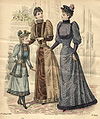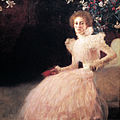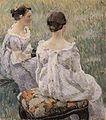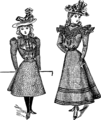1890 American Fashion Ww2 American Fashion

Fashion in the 1890s in European and European-influenced countries is characterized by long elegant lines, alpine collars, and the rise of sportswear. It was an era of peachy wearing apparel reforms led past the invention of the drop-frame safe bicycle, which allowed women the opportunity to ride bicycles more comfortably, and therefore, created the need for appropriate wear.[one]
Another great influence on women's fashions of this era, peculiarly amidst those considered part of the Aesthetic Movement in America, was the political and cultural climate. Because women were taking a more than agile role in their communities, in the political world, and in order as a whole, their dress reflected this change. The more than freedom to feel life exterior the domicile that women of the Gilded Age acquired, the more freedom of movement was experienced in fashions every bit well. As the emphasis on athleticism influenced a modify in garments which allowed for freedom of movement, the accent on less rigid gender roles influenced a change in dress which immune for more self-expression, and a more natural silhouette of women's bodies were revealed.
Women's fashions [edit]

Stylish women's clothing styles shed some of the extravagances of previous decades (so that skirts were neither crinolined every bit in the 1850s, nor protrudingly bustled in back as in the late 1860s and mid-1880s, nor tight as in the belatedly 1870s), but corseting continued unmitigated, or even slightly increased in severity. Early 1890s dresses consisted of a tight bodice with the skirt gathered at the waist and falling more naturally over the hips and undergarments than in previous years. Puffy leg-of-mutton sleeves (as well known as gigot sleeves) made a improvement, growing bigger each year until reaching their largest size around 1895.[2]
During the mid-1890s, skirts took on an A-line silhouette that was almost bell-similar. The belatedly 1890s returned to tighter sleeves oftentimes with small puffs or ruffles capping the shoulder but fitted to the wrist. Skirts took on a trumpet shape, fitting more closely over the hip and flaring just above the knee joint. Corsets in the 1890s helped define the hourglass figure equally immortalized by artist Charles Dana Gibson. In the very late 1890s, the corset elongated, giving the women a slight S-bend silhouette that would be pop well into the Edwardian era.
Sportswear and tailored fashions [edit]

Changing attitudes most acceptable activities for women as well made sportswear popular for women, with such notable examples equally the bicycling clothes and the tennis dress.
Unfussy, tailored clothes, adjusted from the before theme of men's tailoring and simplicity of course, were worn for outdoor activities and traveling.[3] The shirtwaist, a costume with a bodice or waist tailored like a man's shirt with a high collar, was adopted for breezy daywear and became the compatible of working women. Walking suits featured ankle-length skirts with matching jackets. The notion of "rational wearing apparel" for women'southward health was a widely discussed topic in 1891, which led to the development of sports dress. This included ample skirts with a belted blouse for hockey. In addition, cycling became very pop and led to the development of "cycling costumes", which were shorter skirts or "bloomers" which were Turkish trouser style outfits. Past the 1890s, women bicyclists increasingly wore bloomers in public and in the company of men as well as other women. Bloomers seem to have been more than usually worn in Paris than in England or the U.s.a. and became quite popular and fashionable. In the U.s.a., bloomers were more than intended for exercise than style. The rise of American women'south higher sports in the 1890s created a need for more unencumbered motion than exercise skirts would allow. Past the end of the decade, most colleges that admitted women had women's basketball game teams, all outfitted in bloomers.[iv] Beyond the nation'southward campuses, baggy bloomers were paired with blouses to create the kickoff women's gym uniforms.[v]
The rainy daisy was a style of walking or sports skirt introduced during this decade, allegedly named after Daisy Miller,[vi] but also named for its practicality in wet weather, as the shorter hemlines did non soak up puddles of water.[7] They were peculiarly useful for cycling, walking or sporting pursuits as the shorter hems were less probable to catch in the bicycle mechanisms or underfoot, and enabled freer move.[seven]
Swimwear was also adult, usually made of navy blue wool with a long tunic over total knickers.
Afternoon dresses typical of the fourth dimension period had high necks, wasp waists, puffed sleeves and bell-shaped skirts. Evening gowns had a squared decolletage, a wasp-waist cutting and skirts with long trains.
Influence of artful dress [edit]
The 1890s in both Europe and North America saw growing acceptance of artistic or aesthetic wearing apparel as mainstream style influenced past the philosophies of John Ruskin and William Morris.[eight] This was particularly seen in the adoption of the uncorseted tea gown for at-home wear. In the United States during this period, Dress, the Jenness Miller Magazine (1887–1898) [1], reported that tea gowns were being worn outside the home for the kickoff fourth dimension in stylish summer resorts.
Before women acquired a more prominent role outside the home, before they were involved in more community, cultural and political pursuits, a more than traditionally Victorian, restrained, and what was considered modest dress dominated. As Mary Blanchard writes in her article in The American History Review, "Boundaries and the Victorian Body: Aesthetic Style in Golden Age America," "Picayune noticed, but crucial, was a shift in attitudes toward women's style in the 1870s and 1880s, a countercultural shift taking identify under the aegis of the Aesthetic Movement. At this time, some women used their bodies and their dress as public art forms non but to defy the moral implications of domesticity but to assume cultural bureau in their society at large." (Blanchard, page 22)
Hairstyles and headgear [edit]
Hairstyles at the start of the decade were only a carry-over from the 1880s styles that included curled or frizzled bangs over the forehead every bit well as hair swept to the top of the head, merely after 1892, hairstyles became increasingly influenced by the Gibson Girl. By the mid-1890s, hair had go looser and wavier and bangs gradually faded from high fashion. By the end of the decade, hair was oft worn in a large mass with a bun at the top of the head, a way that would be predominant during the showtime decade of the 20th century.
Shoes [edit]
Loftier tab forepart shoes with a large buckle had made a comeback in the 1870s and were again revived in the 1890s. This popular style of shoe had a few names such as "Cromwell," "Colonial," and "Molière".[nine] At this time materials such as suede, leather, lace and metal were used to style the shoe and decorate it. Suede was new to the market in 1890 and was available in a few pale shades.
Athletic wear [edit]
The shift toward functional fashion also afflicted women's athletic clothing. Women in Paris began wearing bloomers when bicycling every bit early as 1893, while in England lower wheel frames accommodated the dresses that women continued to habiliment for bicycling. Long floor length dresses gradually gave fashion to shorter hemlines and a more than casual style of athletic article of clothing. Similarly, bathing suits also became shorter and less covered — yet some other case of the beginnings of a shift in apparel toward greater freedom and functionality.[10]
Mode gallery 1890–1896 [edit]
-

one – 1890–1892
-

two - 1890-1895
-

3 – 1892
-

4 – 1892–93
-

5 – 1893
-

6 – 1894
-

7 – 1895
-

eight – 1896
-

9 - 1896
- Praskovia Tchaokovskaia wears a high-necked afternoon dress with puffed elbow-length sleeves and a fabric belt or sash, Russia, 1890–92.
- Bathing accommodate, 1890-1895, nautical fashion : navy color and sailor collar and sleeves
- Afternoon dresses of 1892 accept low waists and high necklines. Sleeves accept a high, gathered sleeve-head and are fitted to the lower arm. Skirts are fuller in back than front.
- Evening gowns of 1892–three feature brusk or elbow-length full, puffed sleeves and floral trimmings.
- City or traveling suit has full upper sleeves and back fullness in the skirt.
- Walking suits of 1894 show shorter skirts and matching jackets with leg o' mutton sleeves.
- Punch Cartoon of 1895 shows a stylish bicycle suit.
- Natalie Barney in 1896
- Charvet advertising in 1896
Style gallery 1897–1899 [edit]
-

ane – 1897
-

2 – 1897
-

3 – 1897
-

4 – 1898
-

five – 1898
-

6 - 1898
-

7 - 1898
-

viii - 1898
-

nine - 1898-1900
-

x – 1899
-

11 – 1899
-

12 – 1899
- Madame Faydou wears her hair in a knot on top of her caput. Her black apparel and her daughter's grey dress (probably mourning attire) accept fashionable leg o' mutton sleeves, 1897.
- Catherine Vlasto wears a white dress with puffed elbow-length sleeves and ribbon bows. Her hair is parted in the center and poufed casually at her temples, 1897.
- 1897 fashion plate shows an idealized form of the fashionable effigy. The jacket has an asymmetrical closure and new, smaller sleeve puffs.
- Bathing costumes of 1898 have nautical details such as sailor collars.
- Dress of 1898 shows a brusk, wide puff at the shoulder over a long, tight sleeve.
- Charvet corsage of 1898 shows a corsage past Charvet. It is a blouse of pink cambric finely plaited, and with a white pour frill, besides of cambric, downwardly the center.
- Shirt-waist from Charvet in 1898 shows a shirt-waist from Charvet. It has a group of tucks down either side of the front end and back from the shoulders, and in addition has two deep horizontal tucks across the front. A broad box-pleat at the middle is edged with a tiny black frill, which is also carried around the basque. The sleeves are tucked in diagonal groups.
- Hats from manufacturers spring collection
- Ball gown (1898-1900) designed by ane of the finest French couturiers during the Belle Époque, Jacques Doucet, with characteristics of the aesthetic dress movement : "simplistic in pattern, even so extravagant by the pick of materials used. The sheer overlayer is enhanced by the solid lamé underlayers and a sense of luxury is added by the hidden lace flounce at the hem."[11]
- 1899 way plate shows the narrow, gored skirt and more natural shoulder of the start of the 20th century (equally well as the results of "South-bend" corseting).
- Tea Gown of 1899 shows "Watteau back" and frothy trim.
- 2 women in Watteau-backed tea gowns with high sashed waists, 1899.
Cartoons [edit]
-
Cigar box art
-

Cartoon mocking sleeve designs suggesting that new styles could be modeled on cricket bats, hot air balloons, or tennis rackets.
-

1897 advertisement showing woman with unskirted garments for bicycle riding
Men's style [edit]

Early 1890s way includes grey coat with covered buttons and matching waistcoat, dark trousers, short turnover shirt collar, and floppy bow tie. The short hair and pointed bristles are typical. Portrait of Paul Wayland Bartlett by Pearce, 1890
The overall silhouette of the 1890s was long, lean, and athletic. Pilus was more often than not worn brusk, frequently with a pointed beard and generous moustache.
Coats, jackets, and trousers [edit]
Past the 1890s, the sack coat (UK lounge coat) was fast replacing the frock coat for most informal and semi-formal occasions. Iii-piece suits ("ditto suits") consisting of a sack coat with matching waistcoat (U.S. vest) and trousers were worn, equally were matching coat and waistcoat with contrasting trousers. Contrasting waistcoats were popular, and could exist made with or without collars and lapels. The usual style was single-breasted.
The blazer, a navy blue or brightly colored or striped flannel coat cut like a sack coat with patch pockets and brass buttons, was worn for sports, sailing, and other coincidental activities.
The Norfolk jacket remained fashionable for shooting and rugged outdoor pursuits. It was made of sturdy tweed or similar textile and featured paired box pleats over the chest and back, with a material chugalug. Worn with matching breeches (or U.S. knickerbockers), information technology became the Norfolk suit, suitable for bicycling or golf with knee-length stockings and low shoes, or for hunting with sturdy boots or shoes with leather gaiters.
The cutaway morning coat was still worn for formal solar day occasions in Europe and major cities elsewhere.
The most formal evening dress remained a night tail glaze and trousers with a nighttime or light waistcoat. Evening article of clothing was worn with a white bow tie and a shirt with a winged collar.
The less formal dinner jacket or tuxedo, which featured a shawl collar with silk or satin facings, now mostly had a single button. Dinner jackets were appropriate formal clothing when "dressing for dinner" at home or at a men'south club. The dinner jacket was worn with a white shirt and a nighttime necktie.
Knee-length topcoats, often with contrasting velvet or fur collars, and calf-length overcoats were worn in winter.
Shirts and neckties [edit]
Shirt collars were turned over or pressed into "wings", and became taller through the decade. Dress shirts had stiff fronts, sometimes decorated with shirt studs and buttoned up the dorsum. Striped shirts were popular for breezy occasions.
The usual necktie was a four-in-hand or an Ascot tie, made up as a neckband with broad wings attached and worn with a stickpin, but the 1890s also saw the return of the bow tie (in various proportions) for day dress.
Accessories [edit]
Equally earlier in the century, top hats remained a requirement for upper class formal clothing; bowlers and soft felt hats in a variety of shapes were worn for more casual occasions, and flat straw boaters were worn for yachting and at the seashore.
Way gallery [edit]
-

1 – c. 1890
-

2 – c. 1890
-

iii – 1890s
-

iv – 1895
-

5 – 1896
-

6 – 1898
-

7 - 1898
- Painter John Singer Sargent in formal evening dress, c. 1890.
- Another portrait of Sargent, in twenty-four hour period dress: dark coat and waistcoat, dark red ascot, and tall collar, c. 1890. This picture shows the long, lean silhouette in fashion at this fourth dimension.
- Oscar Wilde wears a apron coat with a pocket square, 1890s.
- Frederick Constabulary Olmsted wears a tan topcoat over a grayness suit, 1895.
- George du Maurier wears a double-breasted waistcoat with a shawl collar nether his sack coat, with grey trousers. He wears square-toed shoes with spats, 1896.
- Country clothes: James Tissot wears breeches and loftier boots with a reddish collared waistcoat and a brown coat. Fifty-fifty with this casual outdoor costume, he wears a tie, 1898.
- College way includes a straw boater. William Beveridge at Balliol, 1898.
Children'south way [edit]
-

Daughter with jump rope, 1892
-

Girls, 1896
-

Girls' fashions, 1897
-

Girls, 1897
-

A girl with a doll, 1898
-

Sigrid Juselius, 1898
Working clothes [edit]
-

Cowboys in Texas, 1891
-

Maid, 1892
-

Townswoman and fisherwoman, 1894
-

Rector and drinker, 1894
Notes [edit]
- Reforming Fashion 1850-1914
Meet likewise [edit]
- Corset controversy
References [edit]
- ^ Cunningham, Patricia; Sally Sims (1991). "The Cycle, the Bloomer, and Dress Reform in the 1890s". Clothes and Pop Civilisation . Bowling Green, OH: Bowling Dark-green State University Popular Press.
- ^ Kyoto Costume Found (2002). Fashion: A History from the 18th to the 20th Century. Taschen. p. 299. ISBN3822812064.
- ^ Hollander, Anne (1992). "The Modernization of Fashion". Design Quarterly. No. 154 (Winter, 1992): 27–33. doi:x.2307/4091263. JSTOR 4091263.
{{cite journal}}: CS1 maint: url-status (link) - ^ Warner, 2006, p. 204
- ^ Warner, 2006, p. 206
- ^ Olson, Sidney (1997). Immature Henry Ford : a picture history of the first xl years . Detroit: Wayne State University Printing. p. 84. ISBN9780814312247.
- ^ a b Hill, Daniel Delis (2007). As seen in Vogue : a century of American fashion in advertizement (1. pbk. print. ed.). Lubbock, Tex.: Texas Tech Academy Press. pp. 23–25. ISBN9780896726161.
- ^ Blanchard, Mary W. (February 1995). "Boundaries and the Victorian Torso: Aesthetic Fashion in Aureate Age America". The American History Review. 1. 100 (1): 22. doi:ten.2307/2167982. JSTOR 2167982.
- ^ "Evening Pumps". The Metropolitan Museum of Art.
- ^ B. Payne, "Women's Fashions of the Nineteenth Century", History of Costume: From the Ancient Egyptians to the Twentieth Century (1965)
- ^ Ball gown on Metropolitan Museum of Art.
- Arnold, Janet: Patterns of Fashion ii: Englishwomen's Dresses and Their Construction C.1860–1940, Wace 1966, Macmillan 1972. Revised metric edition, Drama Books 1977. ISBN 0-89676-027-8
- Ashelford, Jane: The Fine art of Apparel: Clothing and Guild 1500–1914, Abrams, 1996. ISBN 0-8109-6317-5
- Blanchard, Mary. "The American History Review: Boundaries and the Victorian Body: Aesthetic Style in Gilded Historic period America," Oxford University Press, 1995. Vol. 100, No. i, pp. 21-l
- Nunn, Joan: Fashion in Costume, 1200–2000, 2nd edition, A & C Blackness (Publishers) Ltd; Chicago: New Amsterdam Books, 2000. (Excerpts online at The Victorian Web)
- Payne, Blanche: History of Costume from the Ancient Egyptians to the 20th century, Harper & Row, 1965. No ISBN for this edition; ASIN B0006BMNFS
- Norris, Herbert, and Oswald Curtis. 19th Century Costume and Style, Mineola, New York: Dover Publications, INC., 1998. 227–229.
- Steele, Valerie: Paris Fashion: A Cultural History, Second Edition. New York: Berg, 1998. 175–176.
- Warner, Patricia. "When the girls came out to play: The birth of American sportswear" Amherst: Academy of Massachusetts Printing, 2006. ISBN 1558495495, ISBN 1558495487
External links [edit]
- Spring fashion, ca. 1890s | "From the Stacks" at New-York Historical Social club
- Fashion-era
- La Couturière Parisienne
- Clothes with Leg o' Mutton sleeves
- 1890s Apparel
- Fitted Sleeves
- Trumpet-shaped skirts
- Bell-shaped skirt
- Tennis Dress
- Hourglass Corset
- Corsets and Crinolines
- S Bend Corset
- What Victorians Wore: An Overview of Victorian Costume
- "19th Century Women's Fashion". Fashion, Jewellery & Accessories. Victoria and Albert Museum. Retrieved 17 February 2014.
{{cite web}}: CS1 maint: url-condition (link) - 1890s Fashions in the Staten Isle Historical Society Online Collections Database
- 1890s Fashion Plates of men, women, and children'south manner from the Metropolitan Museum of Art Libraries


0 Response to "1890 American Fashion Ww2 American Fashion"
Post a Comment